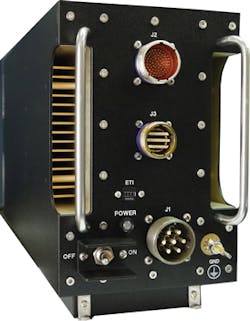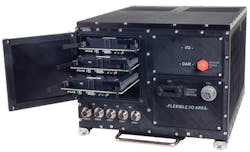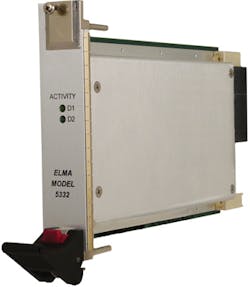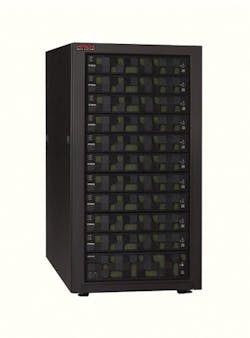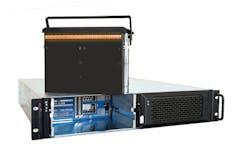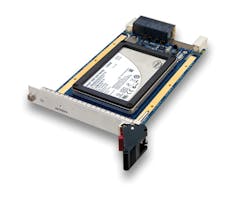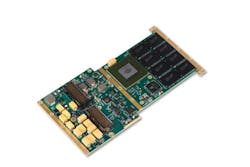Rugged data storage is dominated today by solid-state disks, yet there is still room for rotating hard disks, with emerging requirements for data security and sharing storage devices on networks.
The need for rugged data storage in military and aerospace systems is growing constantly, as manned and unmanned reconnaissance and surveillance sensors proliferate at an astonishing rate, and drive the need for robust and reliable storage for crucial video, signals intelligence information, and multispectral sensor data.
Data storage technologies are evolving quickly, offering many choices for systems integrators who must quickly store terabytes of video, imagery, signals intelligence (SIGINT), and other data-intensive applications. While solid-state storage has become dominant in mission-critical aerospace and defense applications, there is still room for rugged rotating data storage media, while integrators are keeping an eye on new 3D solid-state storage to see if this promising approach becomes rugged enough for military uses.
Data security, meanwhile, represents a growing trend in military data storage not only to ensure that sensitive data doesn't fall into the wrong hands, but also to assure the quality of recorded data, and to make sure that no one has tampered with recorded information.
At the same time, vestiges of cloud computing and big-data are making their way into military and aerospace data storage, as Ethernet-based network-centric storage is helping to reduce size and weight by eliminating the need for each sensor to have its own dedicated data storage system.
Imperatives of data storage
The need for high-speed data storage is pervasive in aerospace and defense applications because of the constant and persistent nature of surveillance and reconnaissance. Sensor data is coming in from reconnaissance satellites, manned aircraft, unmanned aerial vehicles (UAVs), and perimeter-security systems from countless fixed sites. All that data has to go somewhere, and with a growing number of sensors, this data has to be recorded quickly, reliably, and securely.
"We have seen requests for data storage from UAVs, fighter jets, and larger aircraft," says Paul Ambuehl, senior design engineer at Extreme Engineering Solutions (X-ES) in Middleton, Wis. "It's not just one area that is interested in it.
"Something we see a lot of is for data recording applications to capture raw video," Ambuehl continues. "That needs to be dumped quickly from solid-state drives. They can go up to 500 megabytes per second or more, so you can dump compressed video very quickly to these drives."
Data storage media
Solid-state drive (SSD) technology dominates today's aerospace and defense applications that typically are subject to shock, vibration, temperature extremes, and other demanding environmental factors. It's reliable, fast, space-efficient, and can record ever-larger amounts of data. Its downsides, however, involve longevity and price.
Solid-state storage, which relies on various kinds of Flash memory, has a tendency to wear out - not quickly, mind you, but its maximum number of read and write cycles are numbered. Systems designers must keep that in mind, especially for applications that write small bits of data over and over again.
Compared with rotating media, "solid-state devices wear out faster in a transactional environment like a database where you have many small records that are being accessed, written, and erased; that is the worst-case environment for a solid-state disk," says Amos Deacon III, president of data storage specialist Phoenix International Systems in Orange, Calif.
On the other hand, solid-state storage "lasts longer where you have continuous data flow like video, telemetry, or radar," Deacon says.
The cost of solid-state storage has been coming down as its popularity increases, yet it still is relatively expensive - particularly for the ultra- reliable, single-level-cell (SLC) NAND Flash technology favored by those designing high-reliability aerospace and defense systems.
Nevertheless, solid-state storage has taken a lead role in the ruggedized storage market. "We have seen the move from rotating drives to solid-state drives. We almost never use rotating drives anymore," says Paul Davis, director of product management at the Curtiss-Wright Corp. Defense Solutions Division in Dayton, Ohio. In addition to its advantages in size and reliability, solid-state storage technology also is moving forward at a rapid clip. "The amount of data you can get in a certain size is doubling about every 18 months," Davis says.
"Everything seems to be going solid state, which makes sense from a shock, vibration, and temperature perspective," says X-ES's Ambuehl. NAND Flash technology that dominates today's solid-state drives essentially comes in three varieties: single-level cell (SLC), multi-level cell (MLC), and triple-level cell (TLC). MLC and TLC are pushing the bounds of storage capacity and can offer massive levels of storage at reasonable prices.
MLC and TLC Flash are becoming popular for commercial applications, as well as for personal computers. "Large users like Amazon use TLC and MLC because these drives are dense and inexpensive," Ambuehl says. Nevertheless, the smaller-capacity SLC technology still is popular for military and high-reliability applications because of its reliability in harsh environments, and because of its longevity.
"SLC has 10 times as many program erase cycles as MLC, and even more than that compared to TLC," Ambuehl says. In addition, "there is a concern with MLC as far as their data retention at higher temperatures," he says. "Overall SLC is better across the board."
Still, the reliability and longevity of SLC solid-state memory comes at a price. "With SLC there is a large cost adder; SLC is not cheap," Ambuehl says. He estimates that SLC costs about five times as much as MLC for the same storage capacity.
Another market concern about SLC involves its future. Its MLC and TLC competitors offer bigger market potential and larger profits for their manufacturers. Some storage experts worry that the days of SLC are numbered, despite the technology's advantages for military applications.
"The density of MLC is at least twice the density of SLC," Ambuehl says. Also, it's hard to say what the future of SLC will be. Signs are pointing that it might be dying in the future." Solid-state memory experts are investigated new ways of enhancing the reliability of MLC storage, which eventually could make it an attractive option for aerospace and defense uses.
SWaP storage issues
Among the chief advantages of solid-state storage is its small size and weight, compared to older-style rotating hard disks. "In form factor, we had been seeing 1.8- or 2.8-inch SSDs. Now we are seeing different form factors coming into play, and not just the 2.5-inch SSDs," says Ken Grob, director of embedded technology at Elma Electronic in Fremont, Calif. "Today we are seeing sub-credit-card-size solid-state drives. We have seen drives become thinner in applications where designers wanted to fit in more drives."
The relentless march to smaller sizes in solid-state drives shows no signs of slowing. "They just keep shrinking everything down," says Phoenix International's Deacon. "The silicon they use for SSDs keeps getting smaller and smaller. The most recent advances involves 3D SSDs where they are stacking the NANDs themselves vertically. This offers very high capacity at a low price, but is nothing you would want to put in a mission-critical system."
Rotating media
The popularity of solid- state storage still has not spelled the demise of traditional rotating hard disk media, but has shoved rotating media into specific niches in aerospace and defense applications.
"If it is a server-based application we might still see rotating storage," says Elma's Grob. "If it's a shipboard application we would still see the 2.5- and 3.5-inch rotating disks. We could see rotating media in submarines and ground applications. If we have a disk that is not primary data storage, but instead is for an OS or for an application, we could see that in rotating, and we would be looking at the most robust mobile drive we could recommend."
Even though solid-state storage is in the driver's seat, "there is still a lot of rotating media storage requirements out there," says Phoenix International's Deacon.
The decision on whether to use ruggedized rotating data storage essentially boils down to budget, Deacon says. "Solid-state disks have come down in price significantly, but the level of reliability and longevity of the NAND Flash used in solid-state disks to have the level required for a military and aerospace application is still pricey."
Cost is not the only factor in choosing rotating hard disks, either. This storage media has evolved such that it often can stand up to the environmental rigors of airborne, ground, and maritime applications. "Rotating drives are much more robust than they used to be," Deacon says. "We are still putting rotating disks on aircraft - lots of them."
Rotating media also can hold the data longer than solid state, he says. "If you have a solid-state disk, they do wear out," Deacon says. "They degrade over time with the program erase cycles. With rotating disk you don't have to do the erase step; you just write over what's already there."
Deacon says he can help potential customers make the choice between rotating and solid-state disk by creating a simulated mission profile. "You determine what the application is as far as the physical environment, and the data I/O environment as far as the structure of the data - large blocks of synchronous data for video and imagery, or small blocks like a database application. We take the I/O they are using and the amount of data that would be acquired, and then we simulate how many missions the storage device would last."
I/O considerations
The staggering amount of data coming in from today's military surveillance sensors also is placing a heavy load on the storage drive's ability to move data on and off of itself at rapid speeds. "A big trend we see is the write speed into the storage array," says Elma's Grob.
"The amount of data from the sensor has increased rapidly, and that increases pressure to ingest the data and record it in real time, and also to access the information at the same time you are recording," Grob says. "This puts big pressure on the interface of the drive itself."
To keep pace with speed demands, solid-state drives are evolving quickly from SATA II to SATA III to achieve I/O speeds as fast as 6 gigabits per second. At the same time, solid-state drive designers are considering PCI Express, Quadruple Force Decide Redundancy (QFDR), and high-speed Fibre Channel to move data on and off drives as quickly as possible.
Data security
One of the biggest trends in military data storage these days involves securing the information once it's been stored. Most often this is done when a device embedded on the drive encrypts information as it goes onto the drive, and decrypts it when the data comes off. Commonly this is called security or encryption at rest.
This government requirements is in place to keep important information out of the wrong hands should the data storage drive be captured, lost, or "borrowed" by unauthorized personnel when the drive is removed from its host platform. "We encrypt the data before it goes onto the drive so it is secure at rest," says Curtiss-Wright's Davis.
There are several encryption schemes to secure military data at rest, ranging from those administered by the National Institute of Standards and Technology (NIST), to higher levels of classification administered by the National Security Agency (NSA). One good commercial-level of encryption is FIPS 140-2, which is common for military data drives.
"The majority of the time the level of security is determined by the sensor, whether it is flying a highly secret mission over Russia, or one that might have a different level of security like flying over some other country," Davis says.
"Just before it goes onto the disk we encrypt the data. We used a module for encryption depending on if we are doing FIPS or Type 1 [NSA] encryption. We developed our own encryption modules that are NIST-certified." If Curtiss-Wright and other storage manufacturers must meet more stringent NSA encryption requirements, they need to use third-party encryption modules that meet NSA certification.
In addition to encryption, military customers are starting to require anti-tamper technology for data storage devices that ensure the data on the drive is erased or otherwise destroyed if the drive falls into the wrong hands. "Anti-tamper is starting to be a bigger requirement," says Elma's Grob. This can involve secure erase, destructive erase, or other methods that wipe the drive clean.
Network-centric storage
Although still relatively new on the scene, network-centric data storage is getting a foot hold in aerospace and defense applications. This involves several different sensors or processors that share one storage medium, rather than designing systems with separate storage for each sensor or processor.
On a small scale, this can involve a private network like sensors on an aircraft or a ship, and in larger implementations can involve Internet-connected sensors and storage in the cloud. What it really means is sensors and processors don't have to care where the data goes, as long as it's on the network.
"We used to spin-up a lot of disks and store data, with each silo doing its own," says Brian Houston, vice president of Hitachi Data Systems Federal in Reston, Va. "Today we use virtualization from an application layer. We see it as one platform for all data; the protocol shouldn't matter anymore.
"Analytical and virtualization capabilities drive the cost out of the storage environment," Houston continues. "It really comes down to the amount of sensor data that is coming in nowadays, as opposed to five years ago. It is just huge."
